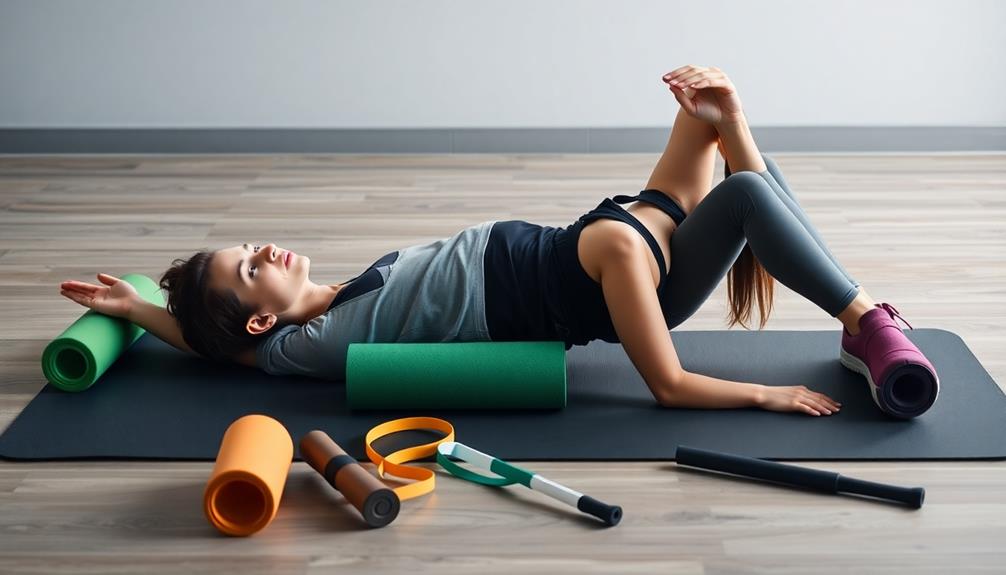To manage post-workout DOMS effectively, focus on three key strategies. First, hydrate and refuel strategically by consuming water or sports drinks with electrolytes, and eating a mix of carbs and protein to replenish your body. Second, embrace active recovery techniques like gentle walking, swimming, or yoga to boost blood flow and ease muscle stiffness. Finally, prioritize quality sleep by aiming for 7-9 hours each night and creating a sleep-conducive environment. These methods work together to reduce soreness, speed up recovery, and improve your overall well-being. Implementing these tips can help you bounce back faster and get ready for your next workout session.
Core Insight
- Hydrate properly with water or electrolyte-rich sports drinks to replace fluids lost during exercise.
- Consume a balanced mix of carbohydrates and protein within an hour after your workout.
- Engage in active recovery techniques like gentle walking, swimming, or yoga to boost blood flow.
- Prioritize 7-9 hours of quality sleep each night in a dark, quiet, and cool environment.
- Use foam rolling or gentle stretching to alleviate muscle tension and promote flexibility.
Hydrate and Refuel Strategically

After your workout, drink water or a sports drink with electrolytes. Aim for 16-20 ounces in the first hour after exercise. This will help replace fluids lost through sweat.
To refuel, eat a mix of carbs and protein. Carbs refill your energy stores, and protein helps repair your muscles. Try having a snack or meal within an hour after your workout. Good options are a banana with almond butter, yogurt with berries, or a protein shake with fruit.
Embrace Active Recovery Techniques

When you're sore, don't just rest. Try active recovery instead. It can help relieve DOMS better. Low-intensity activities boost blood flow to your muscles, which speeds up recovery and reduces stiffness. Gentle movement can ease discomfort and make you feel better overall. Foam rolling is great for targeting specific muscles and releasing tension.
Try these active recovery methods:
- Walking or swimming
- Yoga or gentle stretching
- Foam rolling or self-massage
- Easy bodyweight exercises
Prioritize Quality Sleep

Getting enough sleep is crucial for muscle recovery and reducing soreness after exercise. Aim to sleep 7-9 hours each night. Go to bed and wake up at the same time every day, even on weekends. This helps create a consistent sleep schedule.
Before bed, do relaxing activities like reading or gentle stretching. This signals your body that it's time to wind down. Using essential oil diffusers with calming scents can also help you relax and sleep better.
Make sure your bedroom is dark, quiet, and cool. Use a comfortable mattress and pillows that support your body well. Avoid using electronic devices at least an hour before bedtime, as the blue light can disrupt your sleep.
If you have trouble sleeping, try drinking chamomile tea or taking magnesium supplements. However, always talk to your doctor before using any supplements.
Frequently Asked Questions
How Long Does DOMS Typically Last?
You'll typically experience DOMS for 24 to 72 hours after your workout. It usually peaks around 48 hours post-exercise. However, the duration can vary depending on your fitness level and workout intensity. You'll gradually feel better as time passes.
Can Certain Supplements Help Reduce DOMS Symptoms?
Yes, certain supplements can help reduce DOMS symptoms. You'll find that omega-3 fatty acids, curcumin, and tart cherry juice may ease muscle soreness. Branched-chain amino acids (BCAAs) and creatine can also support muscle recovery and reduce discomfort.
Is It Safe to Exercise When Experiencing DOMS?
Yes, it's generally safe to exercise with DOMS, but listen to your body. You can do light activities or work different muscle groups. If pain's severe or you're concerned, it's best to rest or consult a professional.
Does Age Affect the Severity or Duration of DOMS?
Yes, age can affect DOMS. As you get older, you'll likely experience more severe and longer-lasting muscle soreness. Your body's recovery processes slow down, making it harder to bounce back from intense workouts as quickly as before.
Can Specific Types of Exercises Cause More Intense DOMS?
Yes, certain exercises can trigger more intense DOMS. You'll likely experience stronger soreness from eccentric movements, like downhill running or lowering weights, and from unfamiliar activities that stress your muscles in new ways. High-volume workouts can also intensify DOMS.

